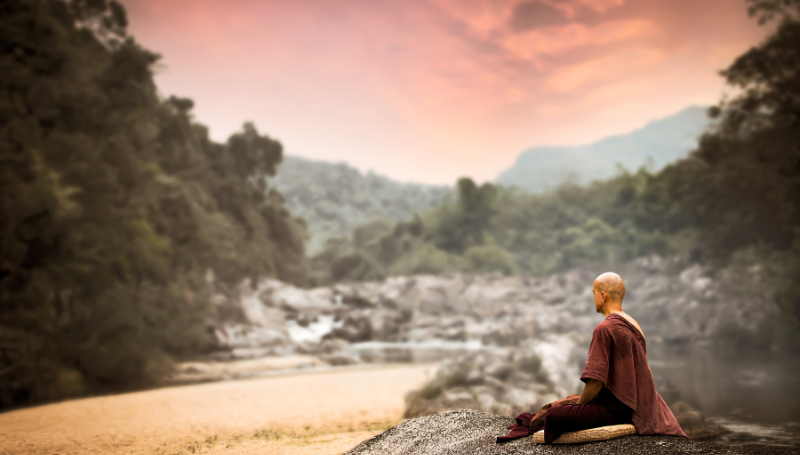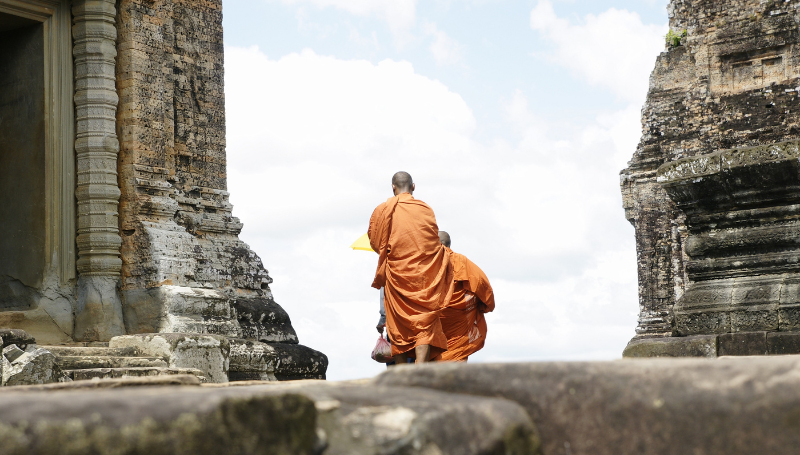The five ego traps to avoid in meditation
(Uplift | Chad Foreman) With so many people joining the meditation revolution, what are some pitfalls to avoid? Learn more about the five ego traps to avoid in meditation.
Techniques to navigate the obstacles on the path to Enlightenment
With so many people joining the meditation revolution, what are some of the pitfalls to be avoided? Generally speaking meditation is meant to eliminate an egoistic self centred attitude which always wants more and more, and replace it with a serene and content – dare I say enlightened – way of being.
But is it possible that meditation can increase your ego and contribute to your emotional and psychological suffering? Tibetan Buddhist Meditation Master Chogyam Trungpa claims that it can do just that and he warns of meditation being an ego trap linked to spiritual materialism. So here are the five ego traps to avoid in meditation.
The five ego traps to avoid in meditation
1. The identification trap
This is probably the most obvious trap, or at least it is obvious to others if you go around claiming you are enlightened, but it is also the most subtle and hard to understand. To believe there is some fixed separate person that is enlightened is exactly what the ego does. The ego is believing in some fixed identity that endures over time, instead of the ever changing relationships and processes that make life what it actually is.
As for enlightenment, that’s just for people who can’t face reality.
– Brad Warner
This trap also includes believing other people like Gurus or Masters to be enlightened; to see them as perfected beings and you as a lower or lesser type of being is exactly how the ego operates; by solidifying and comparing. Believing in others’ identity as perfect is actually just the ego projected outward.
Thinking you are better than another because you are a ‘meditator’ is of course caused by identifying and then comparing. This is an obvious pitfall to be avoided. Try to meditate regularly without labelling yourself a meditator or spiritual or anything else. Live without a story; simply fresh and awake in every moment without an identity.
In meditation we don’t let the mind stick to anything, not identifying with anything, remaining free. Don’t make an ‘I dent’ in any appearance or any thought, just stay open and aware.
The key mistake of this trap is thinking relative appearances can be perfected or completed. Relative appearances will always be changing through stages of birth, temporarily abiding and dying. These natural cycles are perfect in themselves but they are never finished or complete and they certainly don’t stop. To be in the flow with life is the perfect way, but there is no fixed identity doing it.
The key realisation of meditation is there is no-self. The light is on, but there is no-one home, no fixed ego doing everything. This is not philosophy, this can be discovered through meditative introspection. Right now look inward for the thing you call ‘you’ and see what you find. There is spontaneous awareness sensitive to the moment but no one there to do it or gain reward, that is why Buddhists practice non-attachment to the results of actions.
This is difficult for the rational mind to accept, it challenges notions of free will and independence but there are other conceptual alternatives to either thinking there is an enlightened person or not; like what Zen Master Suzuki suggests, “there is no such thing as an enlightened person only enlightened activity” or what the non-dual Master Nisargadatta says:
Wisdom tells me I am nothing, love tells me I am everything, between the two my life flows.

2. The permanency trap
“Ah Ha! I’ve finally got it, I’ve finally arrived” said the ego, “I’ve finally found that perfect philosophy, the right answer and the meaning to life.” This is the permanence trap. As soon as you think you’ve got it, you’ve gone astray, you’ve missed the point of impermanence and you are grasping at something conceptually secure to hold onto in this ever changing world.
The ego grasping onto permanence is so often an intellectual grasping, you think you’ve got it, the answer to your problems, the final conclusion. This is a trap. This dulls the sensitivity to the present moment, it breeds arrogance and ultimately brings huge disappointment. As Zen Master Suzuki says “…the minds readiness for anything is wisdom.” He goes on to warn “that in an expert’s mind there are few possibilities but in a beginners mind there are many.”
It is also very wise to always remember the first line of the Tao Te Ching when you think you’ve finally got the right answer:
The truth that can be named is not the real truth.
Thoughts and concepts are actually kind of permanent – they do not change like material things do. They may be replaced quite readily, but once you’ve decided on an opinion or a conclusion, that thought remains permanent and herein lies the problem. Reality is constantly changing, there is no blanket belief that will cover all events and situations. Alan Watts says it best:
There is a contradiction in wanting to be perfectly secure in a universe whose very nature is momentariness and fluidity. But the contradiction lies a little deeper than the mere conflict between the desire for security and the fact of change. If I want to be secure, that is, protected from the flux of life, I am wanting to be separate from life. Yet it is this very sense of separateness which makes me feel insecure. To be secure means to isolate and fortify the “I,” but it is just the feeling of being an isolated “I” which makes me feel lonely and afraid.

3. The centralization trap
This ego trap I am happy to finally talk about because it is a major mistake people make when practising mindfulness meditation. People often withdraw to a centralised point of observance or witnessing and it feels like there is an isolated and separate thing watching everything else. The problem is so many meditation teachers teach this way of meditating (including me).
It is taught to be detached, to be the silent witness, to let things come and go without being moved from a non judgemental awareness, but this is just a small stepping stone toward the truth of things. The next step is to understand there is no separation between your witnessing awareness and what it is observing. Samadhi is one of the oldest forms of meditation practised by many in ancient India from all different religious sects, and it was what Buddha was training in when he discovered deep truths about things. Samadhi actually means to become one with what your observing. It does not mean to remain separate and aloof, it means to unite fully with your object of observation – there is no difference between you and it. It is total absorption in the moment, actually losing yourself in what you are doing, not gaining or adding a new witnessing self.
Instead of centralizing inward, the idea of meditation is to decentralise outward, disperse yourself into everything. Everything in the moment is you. This is what is meant in a famous line in the Buddhist Heart Sutra when it says “form is emptiness and emptiness is form”. Your empty awareness is not separate from anything, it is actually one and the same with everything.
This is exactly how mindfulness enables ethics, wisdom and compassion; you unite with things so as to understand them, you are them, this is the deepest kind of empathy and the subtlest type of sensitivity. Buddha taught to listen to things and all that you hear is just sound, or to watch things and all that appears is just appearances, no separate person seeing the sights or hearing the sounds, just sounds, just appearances. Once again this is not philosophy, this is the experience found in meditation. This wisdom has been lost in modern McMindfulness as taught by so many of today’s teachers.
4. The accumulation trap
This is a trap warned about by Buddha and later by Zen Master Dogen. When you try and gain something from your meditation you have gone astray especially if you are trying to get enlightened. There is nothing to add and nothing to take away. Gaining or resisting is exactly the attachment and aversion Buddha warned was the cause of all emotional suffering, and what Dogen says is the major mistake of meditation practice.
When you try and accumulate merit or knowledge as taught by religious versions of Buddhism you are developing a super strength ego. Any type of wisdom or virtue that is accumulated falls under the natural law of death and decay, it is not a reliable refuge. Anything that is born will die. It is only in the perfect wisdom of a spontaneously present and open mind that enlightened activity can take place. Be in the moment and leave no trace.
It is the ego’s modus operandus to try and gain and benefit and get something from every moment. There is never any contenment or peace in that approach. The Tibetan Buddhist master Sogyal Rinpoche once said that meditation was simply the practice of contentment. That sounds too simple but it is extremely profound and a lot more difficult than you think.
This pitfall includes the ego trap of developing yourself. Self development needs a timeline, a past and a future and this is exactly the state of mind we are trying to overcome in meditation by being in the eternal now. Forget about ideas of getting better, be totally yourself today and tomorrow be totally yourself. Each day is complete, each moment is complete, don’t compare moments. Your past self and your present self may look different but only when you solidify and compare, solidifying a concept of yourself, comparing and improving are all ego traps to be avoided in meditation.
The greatest instructions I have come across in my 20 years of study are the ones that say don’t try and change anything, don’t manipulate yourself, don’t try and achieve enlightenment, simply allow this moment to be as it is. One famous Tibetan proverb says “this moment as it is, is enlightenment.”

5. The happiness trap
Chogyam Trungpa said that “Enlightenment is ego’s ultimate disappointment.” Why would he say that? It seemed to me for a long time that enlightenment meant I could be happy all the time impervious to whatever was happening and it was the most natural thing in the world to pursue this worthwhile goal. How wrong I was. The Happiness Trap is a title of a fantastic book which outlines using mindfulness as personal therapy and it explains very clearly that the biggest trap we face is wanting to be happy all the time. It just completely goes against reality. The reality of change, the reality of disappointment, the reality of trying and failing. It is the ego’s greatest victory when it convinces you it can protect you from all this stuff. The only realistic way is acceptance.
The more we try to avoid the basic reality that all human life involves pain, the more we are likely to struggle with that pain when it arises, thereby creating even more suffering.
~ Russ Harris, The Happiness Trap
Eckhart Tolle echoes what many great spiritual teachers have said – resistance to the present situation is the root of all suffering. Unfortunately that includes resisting unhappiness, or pain or even depression. As the old saying goes, “what you resist persists.” Allowing space for these things to be and move, actually allows them to pass right on through, it doesn’t mean they won’t return, life is full of suffering, but the good news is nothing is permanent. There is no need to tell ourselves sweet stories or sugar coat reality, as Brad Warner says:
Real wisdom is the ability to understand the incredible extent to which you bullshit yourself every single moment of every day.
Being intimate with reality
Trying to be happy all the time you end up like Ned Diddley Dandy Flanders, that Simpsons character that always tries to be happy and positive, and comes off just a little bit scary and neurotic. Perhaps like a happiness junkie addicted to seeing the bright side of every situation. But it’s ok to be sad, it’s ok to grieve the loss of loved ones and it’s ok to not be perfect, that’s just being perfectly human.
Meditation is not about trying to escape or transcend into something otherworldly, it’s being intimate with reality, seeing things as they are not how you would like them to be. It is from this place of acceptance that effective changes can be made because you are perfectly aware of the situation.
Source: Uplift
You may also like:




